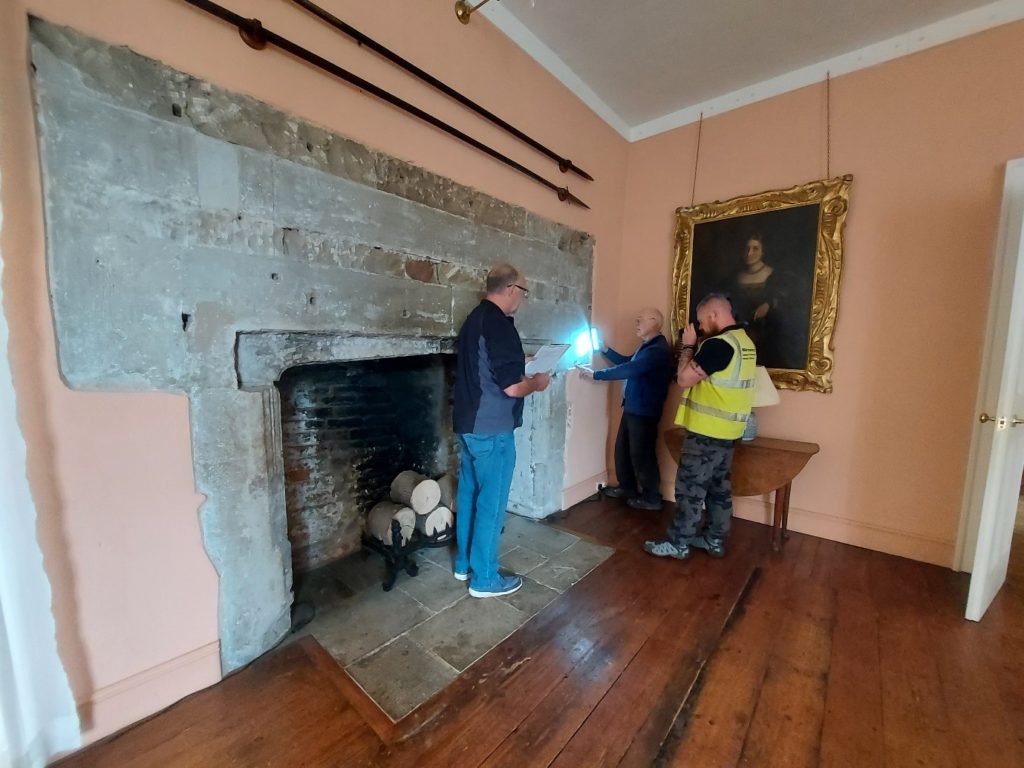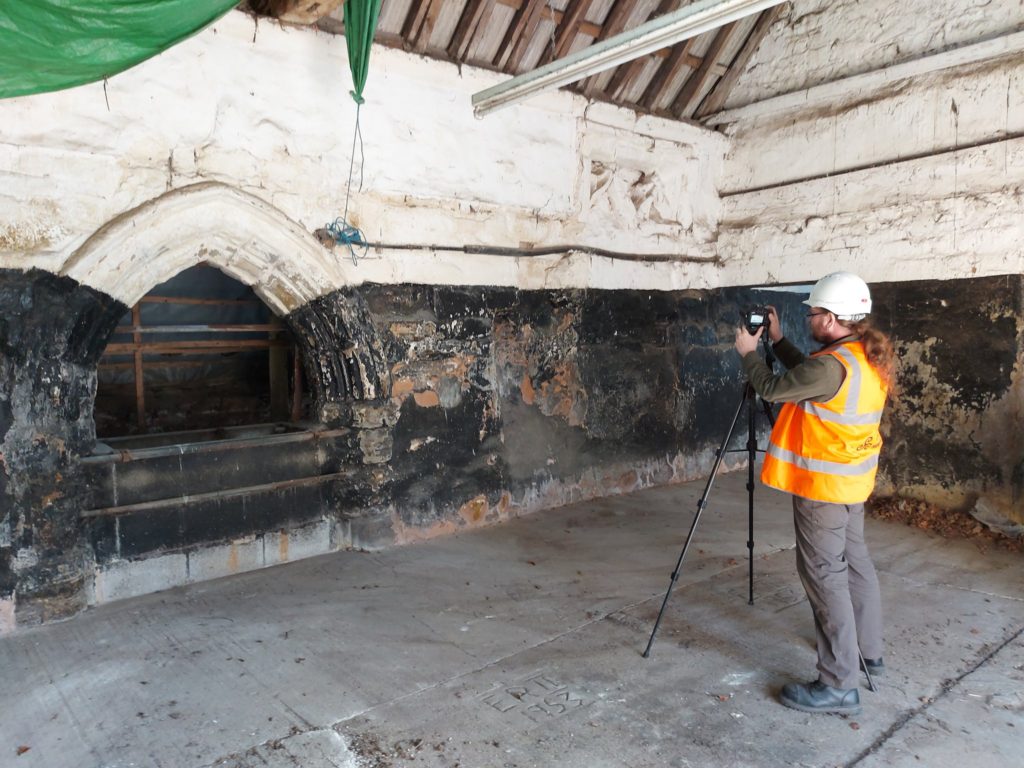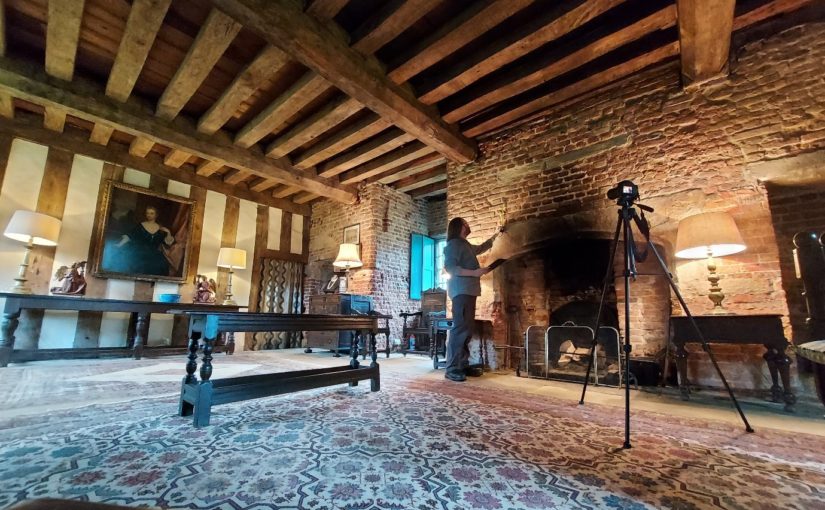James Wright FSA, buildings archaeologist and project lead on our Greasley building survey project takes a look at how buildings archaeology can help us understand castles.
The study of mediaeval castles, palaces or great houses and the discipline of buildings archaeology have closely related histories. The Castle Studies Trust has asked me, as a buildings archaeologist with a long-established research interest in such structures, to write a blog outlining these relationships.
Subscribe to our quarterly newsletter
Buildings archaeology has been defined as: ‘the study of buildings as archaeological objects in their own right… the development of structure… fabric, form and function’ (Morris 2000, 14). Ultimately, the subject demands the forensic methods associated with the careful unpicking of stratigraphy in below-ground archaeological excavation but applies those techniques to standing buildings.

Early Castle Studies: Military Historians
Although some antiquarians had demonstrated an interest in the structures of castles, most early castle specialists approached the subject from the archives. Scholars such as G. T. Clark (1884) and Alexander Thompson (1912) were concerned with documented building phases, ownership of castles and events which took place within their walls. Both authors were also very concerned with military matters and, for them, the castle was primarily a defensive fortification.
The military focus dominated castle studies for around a century. Philip Warner (1973, 8), a senior lecturer at the Royal Military Academy, summed this up when he stated the principal purpose of a castle was: ‘for delaying and dislocating an invading army.’ David Stocker (1992, 415-20) has pointed out that the prevailing notion that castles were primarily fortifications was perhaps due to so many castle scholars having seen military service.
Alternative perspectives can be traced back as far as Ella Armitage (1912, 8) who acknowledged the military uses of castles, but also emphasised their important domestic aspects as: ‘private fortified residences of great landowners’. This balance of military and residence can then be felt in the writings of Reginald Brown (1954), Colin Platt (1982) and Norman Pounds (1990).
Throughout much of the twentieth century the study of castles tended towards a sharp division of labour between historians and archaeologists who rarely collaborated. When the two disciplines were brought together the results were generally much improved – as happened with Howard Colvin and Philip Rahtz’s work on the royal palace at King’s Clipstone (Rahtz & Colvin 1960, 21-43). However, it was still the case that Colvin looked in the archives whilst Rahtz wielded his trowel and the standing architecture was largely overlooked.
Modern Castle Studies: A Holistic Approach
Subsequently, an emerging generation of researchers sought a more holistic approach which skilfully entwined archival sources, archaeological excavation, art and architectural history, landscape studies and the physical examination of standing buildings. Important re-assessments of sites, such as Bodiam Castle, placed emphasis on the symbolic and prestigious aspects of castles rather than the military versus residential debate (Coulson 1992; Everson 1996).

Buildings archaeology helped to revolutionise approaches to interpreting castles through the work of scholars, such as Philip Dixon and Pamela Marshall, who engaged with high quality, site-specific studies including Knaresborough Castle (Dixon 1990), Hedingham Castle (Dixon & Marshall 1993) and Newark Castle (Marshall 1998). Such work helped to build up a strong body of published fieldwork that chimed with a newly complex view of castles. Such projects placed castles in their contemporary moment as a mechanism for understanding the mediaeval lived experience.
With castle studies no longer shackled to rigid debates, the discipline was truly able to take wing. Oliver Creighton (2002, 2009) developed research into castle landscapes, Matthew Johnson (2002) took a strong theoretical approach and Robert Liddiard (2005) offered the wider context into which castle studies could be framed. Meanwhile, the multi-disciplinary investigation of individual buildings such as the Tower of London (Impey 2008), Knole (Cohen & Parton 2019) and Oxford Castle (Munby et al 2019) have remained central.

Investigating Castles
When approaching a new site, such as the recent survey of the late mediaeval courtyard house at Holme Pierrepont, I first like to walk around the entire building with the landowner or curator. This recce is one of the most important moments, as the site is gradually revealed, and I can listen to my companion’s impressions of a structure that they know intimately. However, it is important to maintain a level of detachment – misidentifications, mistakes and myths can creep into the dialogue. This is why I also have a preference for not doing a deep dive into the documents prior to visiting a castle. I find it useful to let the structure “speak” without what can often be conflicting archival sources distracting me.
Then the real work begins! It is important to approach the survey methodically. When working at Tattershall Castle, I concentrated on the structures of each enclosure separately: starting with the gatehouse to the Outer Ward and gradually working my way, structure by structure, into the heart of the castle. This technique allowed a detailed progression of land-use to emerge in a sequence that would be recognisable to the lived experience of a mediaeval visitor to the castle. The last building that I tackled was the great tower – the most significant, complex and private space of the castle (Wright 2021).

Although we can employ many pieces of equipment – digital cameras, drones, total stations, laser scanners and sampling for dendrochronology (all very useful for data gathering) – the most essential gear on site are the eyes and experience of the buildings archaeologist. Trained observation and interpretation are key. Therefore, my first task at sites, such as Greasley Castle, will be to either create measured drawings – floor plans, elevations and sectional-elevations – of the building or to check, add to and annotate pre-existing surveys. Quantifying what is actually present on site underpins analysis. We can also create new data by producing measured sketches or scaled drawings of features such as roof structures and areas of the building which are difficult to photograph due to spatial constraints.
Observations on site might include noting the stratigraphical relationships between different phases of structures – a mediaeval window blocked in the post-medaeval period at Greasley Castle, the fifteenth century great tower at Tattershall Castle which abuts a thirteenth century mural tower (Wright 2021), or evidence for the wholesale reorganisation of roof structures at Knole (Sorapure & Wright 2013, 263-70). Depth is given to the survey by noting the stylistic typologies of particular structures – a Norman doorway at Kings Clipstone, thirteenth century window tracery at the Palace of Westminster or a late mediaeval chimneypiece at Nottingham Castle (Wright 2016, 34-37; Wright 2014; Wright 2017a, 19-23). Recording details such as mason’s marks, carpenter’s assembly marks and historic graffiti at Knole and Home Pierrepont Hall added to the understanding of the human agency behind the construction and occupation of the buildings (Sorapure & Wright 2013-14, 263-70).

Each space will be recorded systematically – usually (but not exclusively) starting at the bottom and working upwards, before looking at the exteriors. When all of the areas of the building have been drawn and annotated, it is time to move on to a comprehensive photographic survey, including both general and detailed shots. It is particularly important to capture all of the relevant data, whilst still on site to refer back to during the write up.
A standing building report will usually comprise two principal elements. Firstly, comes the historical background which establishes the known history of the structure based on a trawl of archival and published sources. At Tattershall Castle these included the 1231 licence to crenellate, building accounts from the 1430s and 40s, biographical data on its patron Ralph Lord Cromwell, parliamentary records of the slighting in 1650, antiquarian images showing its visual appearance in the eighteenth and nineteenth centuries and the letters and papers of Lord Curzon which related to the castle’s conservation in the 1910s (Wright 2021; Wright 2020). It is crucuial to tell the whole story of the castle from its inception right up to the modern day. Secondly, the archaeological analysis of the structure will link back to historical events which may have led to alteration of the structure of the castle. This analysis is typically ordered either chronologically or by physical space, sometimes a mixture of both. The text will be liberally illustrated with photographs, historic images and measured drawings.
There are many ways in which buildings archaeology can be reported. These include site reports, published articles, books, websites, blogs, social media posts, press reports, guidebooks, on-site interpretation, mobile apps, film-making and interpretation panels. A mixture of platforms has become the norm, but reporting is literally the most important part of any archaeological project. There is simply no point doing the fieldwork if you don’t tell other people what you have found!

Conclusions
The incorporation of modern buildings archaeology into castle studies helped to fill a fundamental gap left by projects that had previously concentrated on archival research or archaeological excavation. By taking a detailed approach to the analysis of standing structures, alongside other data streams, the scholarship was able to move on to vital new interpretations.
In my own work on castles, I have been able to apply buildings archaeology techniques to better understand the form, function, building materials, phasing, development and histories of entire sites such as Tattershall Castle or Kings Clipstone Palace (Wright 2021; Wright 2016). It has also led to significant discoveries, such as the identification of Edward IV’s personal livery badge on a chimneypiece at Nottingham Castle or graffiti connected to the Gunpowder Plot at Knole (Wright 2017a, 19-29; Wright 2017b, 78-80). Meanwhile, on my most recent sites, at Holme Pierrepont Hall and Greasley Castle, we are helping to provide an understanding of the archaeological phasing of structures which have previously eluded specialist attention.
Subscribe to our quarterly newsletter
Declaration
Elements of this blog have been remodelled from Wright, J., 2021, ‘Background to English Castle Studies’ in Tattershall Castle: Building a History. Unpublished PhD thesis. University of Nottingham.
About the author
James Wright of Triskele Heritage is an award-winning buildings archaeologist. He has a long-lived research interest in mediaeval castles, palaces and great houses. He has worked on surveys of buildings including the Tower of London, Nottingham Castle, Knole, Holme Pierrepont Hall and the Palace of Westminster. He has written books on Tattershall Castle, Kings Clipstone Palace and the castles of Nottinghamshire. He is currently engaged in a building survey, funded by the Castle Studies Trust, at Greasley Castle.
Featured image: Buildings archaeology survey at Holme Pierrepont Hall (Picture: James Wright / Triskele Heritage)
References
Armitage, E., 1912, The Early Norman Castles of the British Isles. John Murray. London.
Brown, R. A., 1954, English Medieval Castles. Batsford. London.
Clark, G. T., 1884, Medieval Military Architecture in England Vol. 1 & 2. Wyman & Sons. London.
Cohen, N. & Parton, F., 2019, Knole Revealed. National Trust. Swindon.
Coulson, C., 1992, ‘Some Analysis of Bodiam Castle, East Sussex’ in Harper-Bill, C. & Harvey, R. (ed.s), Medieval Knighthood Volume 4. Boydell Press. Woodbridge.
Creighton, O., 2009 (2013 edition), Designs Upon the Land – Elite Landscapes of the Middle Ages. Boydell & Brewer. Woodbridge.
Creighton, O., 2002, Castles and Landscapes. Equinox. Sheffield.
Dixon, P., 1990, ‘The Donjon of Knaresborough: the Castle as Theatre’ in Château Gaillard Vol. 14. Publications du CRAHM.
Dixon, P. & Marshall, P., 1993, ‘The great tower at Hedingham Castle: a reassessment’ in Fortress Volume 18. Beaufort Publishing. Liphook.
Everson, P., 1996, ‘Bodiam Castle, East Sussex: Castle and its Designed Landscape’ in Château Gaillard Volume 17. Publications du CRAHM.
Impey, E. (ed.), 2008, The White Tower. Yale University Press. New Haven and London.
Johnson, M., 2002, Behind the Castle Gate. Routledge. London.
Liddiard, R., 2005, Castles in Context. Windgatherer Press. Macclesfield.
Marshall, P., 1998, ‘The Twelfth-Century Castle at Newark’ in Alexander, J. (ed.), Southwell and Nottinghamshire: Medieval Art, Architecture and Industry. British Archaeological Association Conference Transactions Volume 21. British Archaeological Association. London.
Morris, R. K., 2000, The Archaeology of Buildings. Stroud. Tempus.
Munby, J., Norton, A., Poore, D. & Dodd, A., 2019. Excavations at Oxford Castle: 1999-2009. Oxford Archaeology. Oxford.
Platt, C., 1982 (1995 edition), The Castle in Medieval England & Wales. Chancellor Press. London.
Pounds, N. J. G., 1990, The Medieval Castle in England and Wales: A Social and Political History. Cambridge University Press. Cambridge.
Rahtz, P. & Colvin, H. M., 1960, ‘King John’s Palace, Clipstone, Nottinghamshire’ in Transactions of the Thoroton Society of Nottinghamshire Vol. 64. Thoroton Society. Nottingham.
Sorapure, D. & Wright, J., 2013-14, ‘Water Court: smaller and quite demure’ – A recent building survey of a forgotten late medieval courtyard at Knole, Kent’ in Castle Studies Group Journal Volume 27. Castle Studies Group.
Stocker, D., 1992, ‘The Shadow of the General’s Armchair’ in Archaeological Journal Volume 149. Royal Archaeological Institute. London.
Thompson, A. H., 1912, Military Architecture in England During the Middle Ages. Henry Frowde / Oxford University Press. Oxford.
Warner, P., 1973, The Medieval Castle – Life in a fortress in peace and war. Book Club Associates. London.
Wright, J., 2021, Tattershall Castle: Building a History. Unpublished PhD thesis. University of Nottingham.
Wright, J., 2020, ‘Tattershall Castle and the Newly-built Personality of Ralph Lord Cromwell’ in The Antiquaries Journal, 1-32. doi:10.1017/S0003581520000505
Wright, J., 2017a, Nottingham Castle – Service Court Arches and Inner Bailey Moat Revetment: Worked Stone Assessment. Unpublished archaeological report. Triskele Heritage.
Wright, J., 2017b, ‘Cultural anxieties and ritual protection in high-status early-modern houses’ in Billingsley, J, Harte, J. & Hoggard, B., Hidden Charms – A Conference Held at Norwich Castle: April 2nd, 2016. Northern Earth. Mytholmroyd.
Wright, J., 2016, A Palace For Our Kings – the history and archaeology of a Mediaeval royal palace in the heart of Sherwood Forest. Triskele Publishing. London & Cheltenham.
Wright, J., 2014, Archaeological Assessment of Stonework on the River Thames Foreshore at Victoria Tower Gardens. Unpublished archaeological report. MOLA.
